 |
 |
|
| Jim Worthey • Lighting & Color Research • jim@jimworthey.com • 1-301-977-3551 • 11 Rye Court, Gaithersburg, MD 20878-1901, USA |
|
|||||||
|
|
|||||||
|
| Timeline of
Science and Lighting |
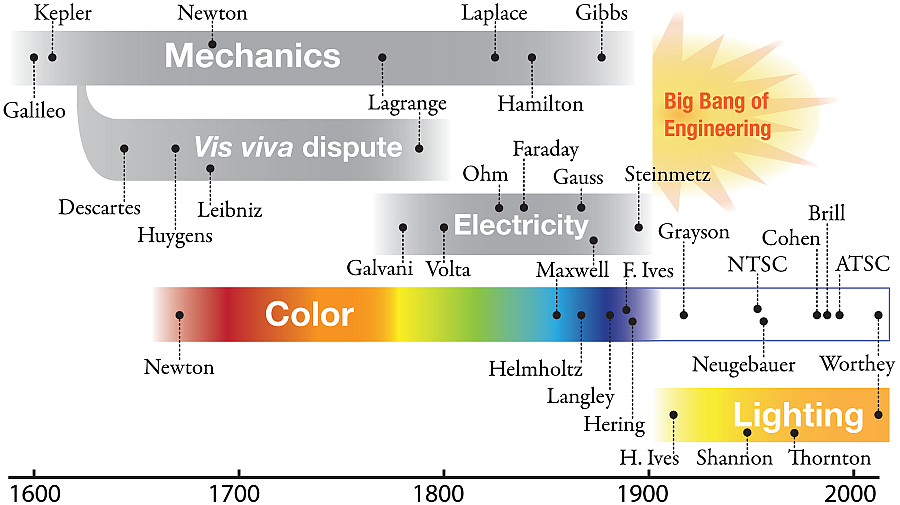

| "A Mixture of
Monochromatic Yellow and Blue Light" |
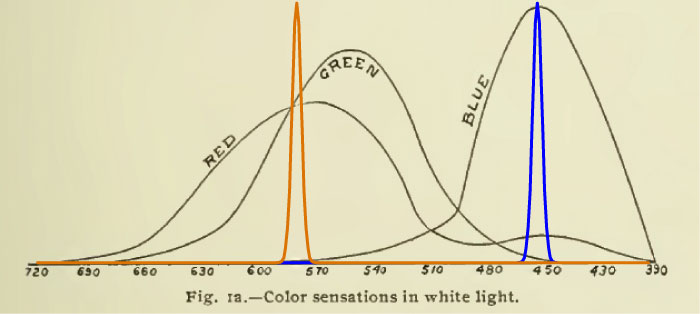
The black lines are Ives’s original drawing, while the orange and blue are added to represent his “mixture of monochromatic yellow and blue light.” Color vision is trichromatic, but monochromatic yellow stimulates two receptor systems because of the large overlap of the red and green sensitivities.
| Ives Took a
Scientific Approach. |
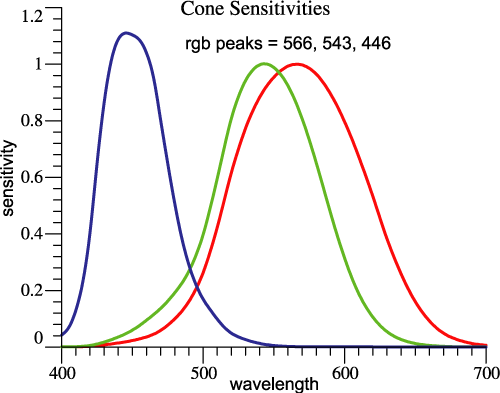 |
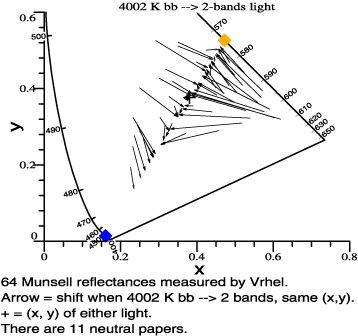 |
| A modern version of red-green-blue. | Example like Ives's: Papers lose their color when 4002 K blackbody is replaced by a 2-band light of the same chromaticity. |
| 2-bands Issue
Since 1912 |
 William A. Thornton 1923-2006 |
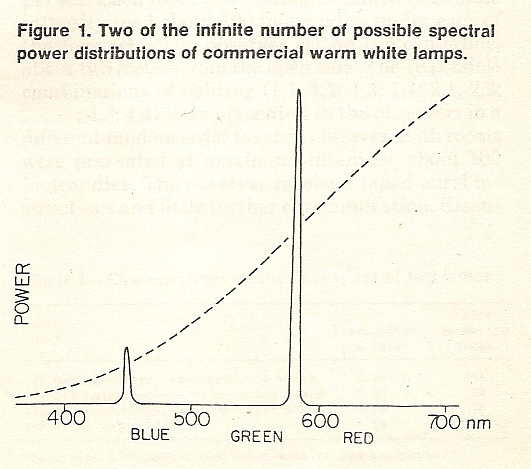 A figure from Thornton, William A. and E. Chen, “What is visual clarity?” J. Illum. Eng. Soc. 7(2):85-94 (January 1978). |
 In the 1970s, Bill Thornton studied the idea of 3-band lamps. He re-discovered Herbert Ives's idea, figure at left. |
 In the 1980s and since, Worthey has expanded on the two-bands idea, noting that many commercial lights shrink red-green contrasts among objects. See figure above. |
| Why Is it Hard
to Discuss Vision and Lighting? |
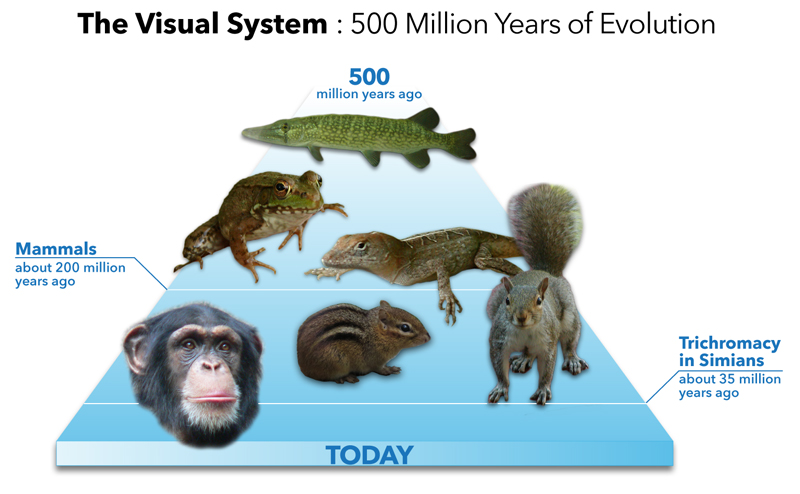
The normal process of seeing is
effortless. Talking about it is harder.
| Vectorial Color Overview (part 1) |
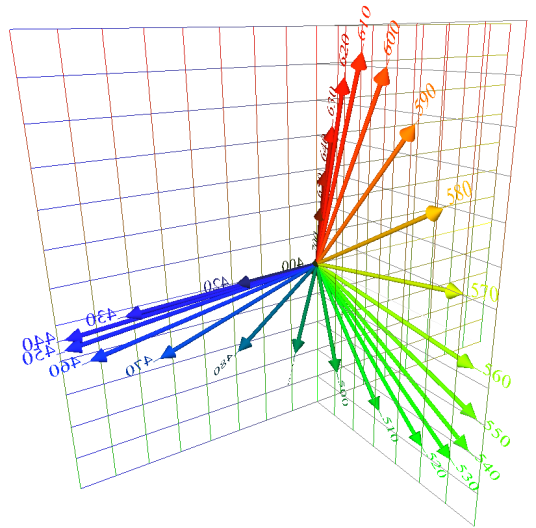 |
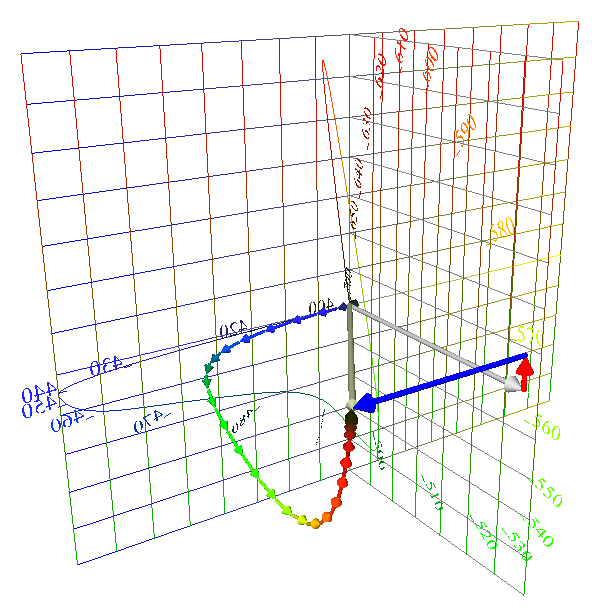 |
| Narrow-band
lights of equal power map to vectors with different
amplitudes and directions. |
Colored
lights add vectorially. In this figure, equal-power
components add to make the so-called Equal Energy
Light. |
| Vectorial
Color Overview
(part 2) |
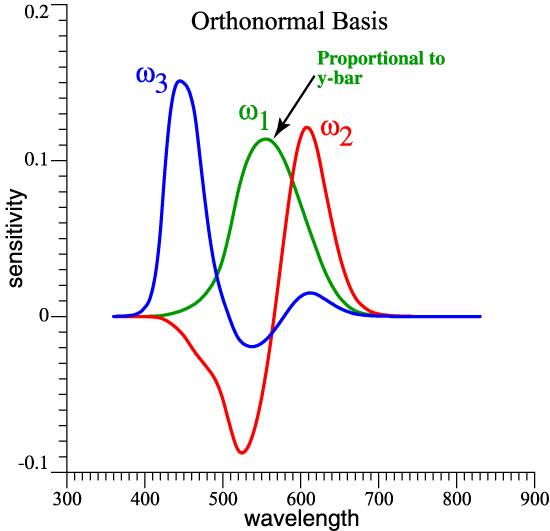 |
  |
| Starting with a light
(an SPD), to find its 3-vector, we need these
Orthonormal Opponent Color Matching Functions. |
For convenience, the functions ω1, ω2, ω3 become the columns of matrix Ω . |
| Vectorial Color
Overview (part 3) |
|
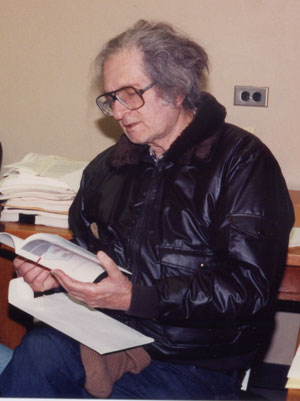 Jozef
B. Cohen
1921-1995 |
| Legacy
Understanding |
|
Fictitious but realistic color-matching data. |
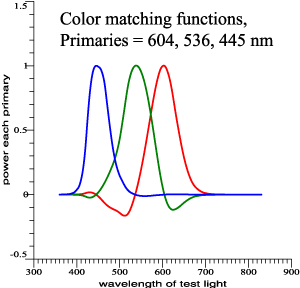 |
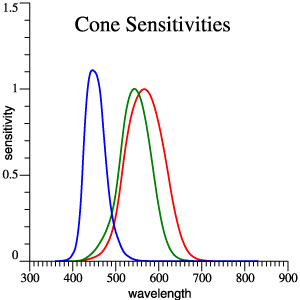 |
Cones,
red,
green
and blue. |
| Traditional
x-bar,
y-bar, z-bar |
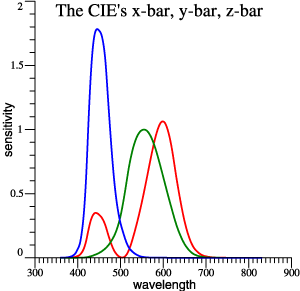 |
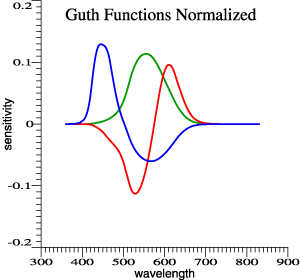 |
Guth's 1980
model, normalized. Achromatic function is proportional
to y-bar. |
|
Linear
transformations of color-matching data predict the
same matches.
This is Figure 1. < The only numbered figure! > |
|||
| 3 functions become
the columns of a matrix: |
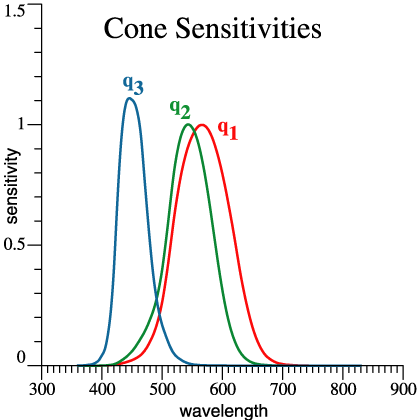 |
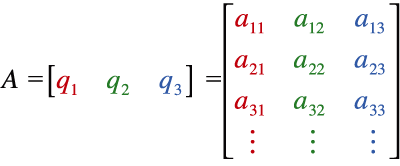 (Eq. 1) |
| A set of
color matching functions, CMFs, become the columns
of a matrix A. Or, if you like, the columns of A are a set of linearly independent functions, usually 3 functions. |
|
| SPD as a Column
Vector |
| The
spectral
power distribution of any light can be written as a
column vector L1.
It is then summarized by a tristimulus vector V, V = AT L1
. (2)
Light L1 is a color match for light L2 if AT L1 = AT L2
. (3)
Refer again to the Figure 1. If Eq. (3) holds for one set of CMFs A, then it will hold for the other sets. That much is standard teaching. |
 |
| Color Mixing Experiments: Choice of
3 λs . |
| Strongly Acting Wavelengths |
| Some
Credit to Tom N. Cornsweet |
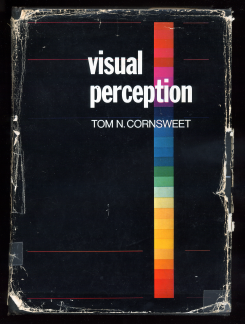 |
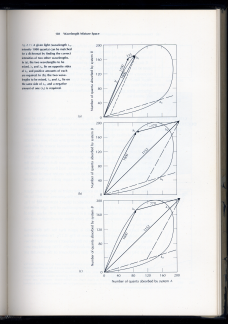 In his 1970 Book, Tom Cornsweet used vector diagrams to
discuss overlapping receptor sensitivities.
|
| Jozef Cohen and the Fundamental Metamer |
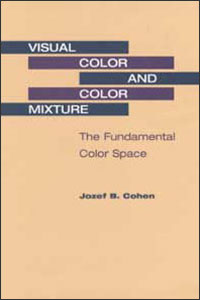 Jozef B. Cohen's Book |
 |
Cohen
sought an invariant
presentation of color mixing facts.
|
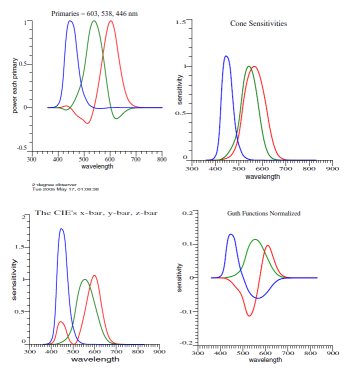 4 Legacy Graphs |
| Examples of
Fundamental Metamers. |
| 4 items:
Fundamental metamer of a narrow band. 1 item: Fundamental metamer of D65. Fundamental metamer is always a smooth curve. |
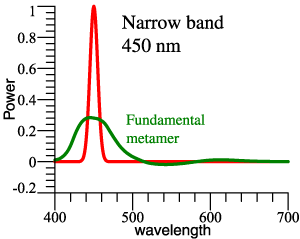 |
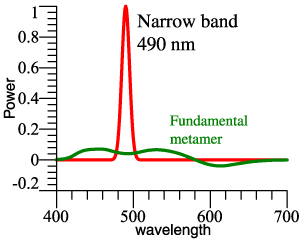 |
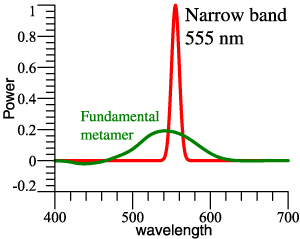 |
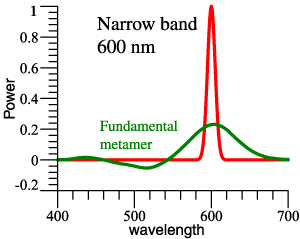 |
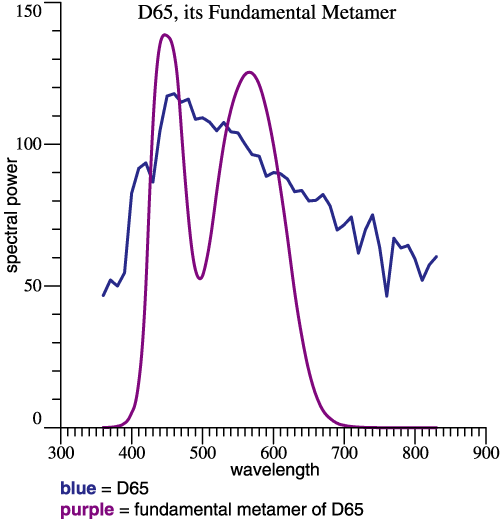 |
| Joe Cohen's
easy method: Matrix R
|
| Cohen needed a way to find a fundamental metamer L* . As before, A is a matrix whose columns are a set of CMFs, | |
 |
. (1) |
| Given L and
A, we want to find L* . Now a student
might look up Moore-Penrose
pseudo-inverse and get a numerical answer L*
with that . Lucky for us, Cohen did not have Wikipedia
and solved the problem for himself, which led him to
more ideas. Long story short, Cohen's method: L*
= R L
,
(2)
whereR = A(ATA)−1AT
.
(3)
|
|
| Matrix R,
continued. |
|
Fun Facts
about Matrix R
|
| Fundamental
Metamer Example. |
 |
At left, the blue curve shows L = D65. The
purple curve is L*,
the fundamental metamer of D65. The two curves are
metamers in the ordinary sense. L*, a linear
combination of CMFs, is found by: L* = RL
. (4)
Eq. (4) has '=' and not '≈' because L* by definition is the least-squares approximation. So that’s Jozef Cohen’s
Highly Original Contribution. Now a few screens above,
We were talking about vectors... |
| Cohen References: Cohen, Jozef, “Dependency of the spectral reflectance curves of the Munsell color chips,” Psychonom. Sci. 1, 369-370 (1964). Cohen, Jozef, Visual Color and Color Mixture: The Fundamental Color Space, University of Illinois Press, Champaign, Illinois, 2001, 248 pp. <2014 update: book is out of print. Publisher has allowed a version to be posted on Google Books. Check it out! > |
|
| Orthonormal
Opponent Color Matching Functions. |

| Orthonormal
Opponent Color Matching Functions: Description. |
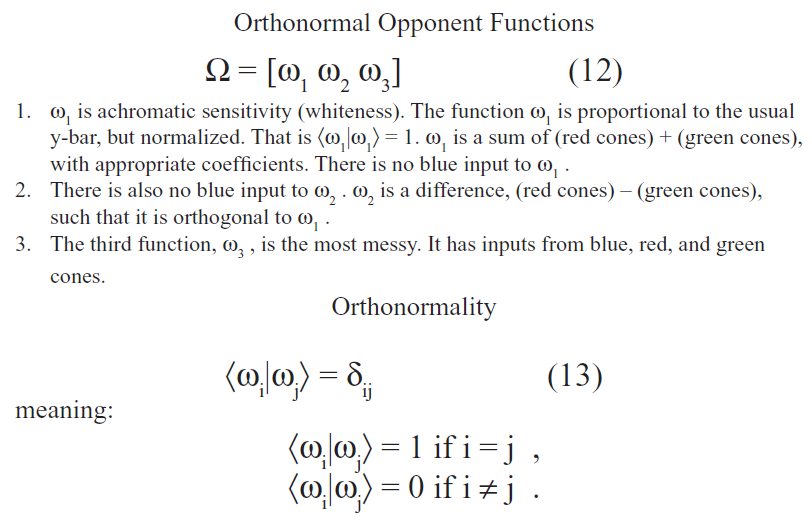
| Bra
and
Ket Notation |
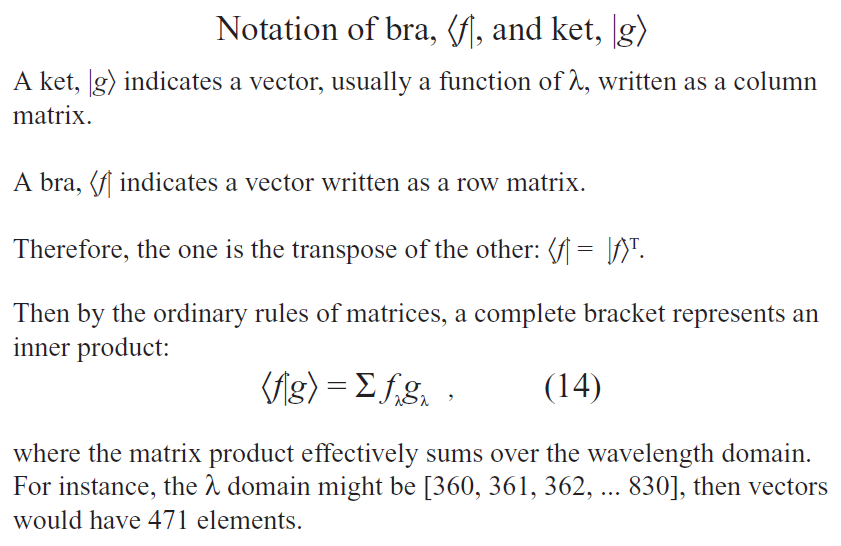
| Working Class
Summary |
| Although many clever
ideas (from Cohen, Guth, Thornton, Buchsbaum, etc.)
guided its development, in the end the orthonormal
basis is not radically new: |
|
 |
|
| Fun with Matrices |
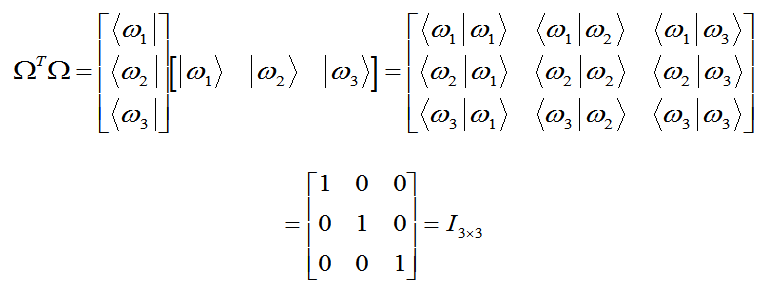 |
(15) |
| Convenience of the
Orthonormal Basis |
| Recall from a
few screens above: |
 |
  Given light L, find its 3-vector V by a matrix multiplication. Ω is known and constant. |
| Starting with a light (an
SPD), to find its 3-vector, we need these Orthonormal
Opponent Color Matching Functions. |
For convenience, the functions ω1, ω2, ω3 become the columns of matrix Ω . |
| Meaning of
Tristimulus Values |
| v1
= whiteness = achromatic
or black-white dimension v2 = redness or greenness v3 = blueness or yellowness So, we can say that the tristimulus values have intuitive meaning. But that's not all. |L*〉 = v1|ω1〉
+ v2|ω2〉 + v3|ω3〉
If we express the
fundamental metamer L* by an orthonormal
function expansion, the tristimulus values are the
coefficients. The same
values have mathematical
meaning. |
| Graphing a Vector |
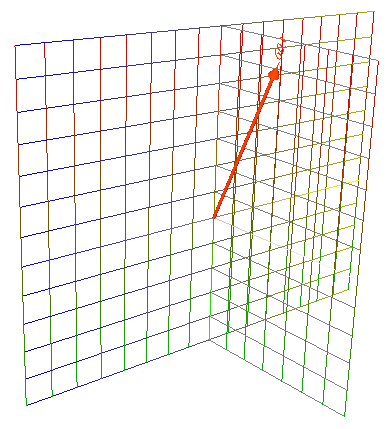 |
So, we can calculate one vector from the
origin. |
| 5 Vectors |
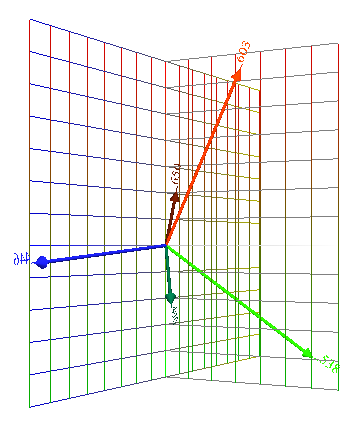 |
Or five vectors from the origin. |
| 5 Vectors Added |
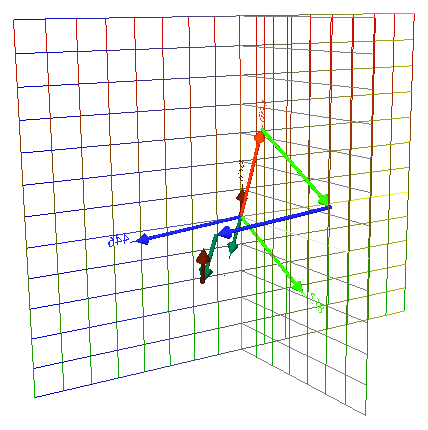 |
Or add some vectors vectorially. That is they add tail to head. |
| Locus of Unit
Monochromats |
| Locus of Unit
Monochromats (continued) |
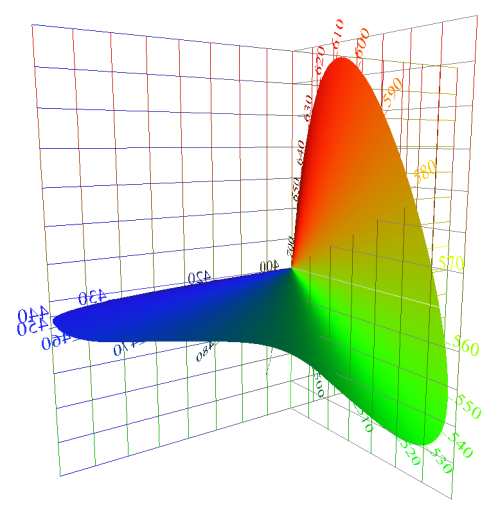 |
I sometimes show the Locus of Unit Monochromats (LUM) by a surface. The locus is really the curve along the edge of the surface. |
| Wavelengths of
Strong Action |
| The NTSC phosphors are approximately at Thornton’s Prime Colors, 603, 538, 446 nm. | |||||||||||||||||||||||||||||
For practical purposes, the wavelengths of the longest vectors are the same as the prime colors, and about the same as the NTSC phosphors. |
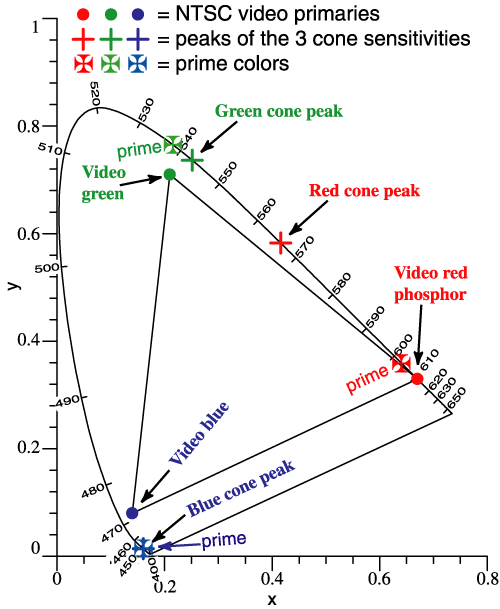 |
||||||||||||||||||||||||||||
| Composition of a White Light |
|
The so-called "equal energy light" is one that has constant power per unit wavelength across the spectrum, indicated by a solid black line in the figure at the right. The straight-line spectrum is similar to a more realistic light, 5453 K blackbody (or 5500 if you like). Now assume an equal-energy light that packs all of its power at the 10-nm points, 400, 410, ... , shown by the green dots. |
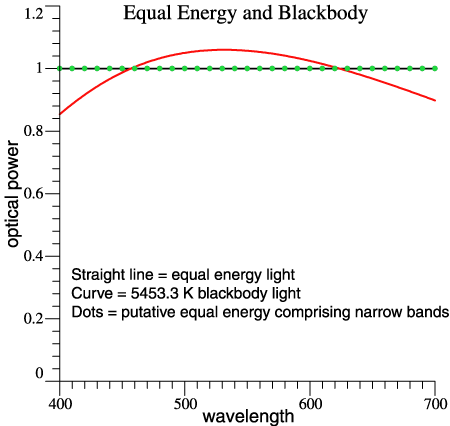 |
| Composition of a White Light
(continued) |
| Opponent Colors
and Information Transmission |
| In 1983,
Buchsbaum and Gottschalk derived an opponent-color
system to optimize information transmission. They
started with cone functions and got a result like the
orthonormal basis Ω . It is perhaps intuitive that Ω is helpful for engineering work because redundancy is taken out. The Buchsbaum and Gottschalk result supports the use of Ω for image compression and propagation-of-errors, for example. [Gershon Buchsbaum and A. Gottschalk, “Trichromacy, opponent colours coding and optimum colour information transmission in the retina,” Proc. R. Soc. Lond. B 220, 89-113 (1983).] |
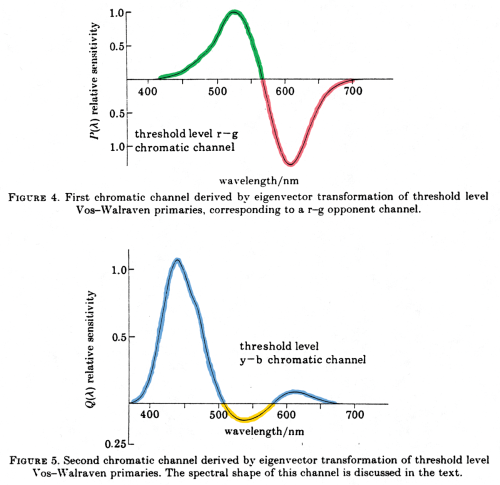 |
| Some Lights
Have Less Red and Less Green |
|
A white light has net redness or
greenness that is small or zero. The same white point
can be reached by different lights in different ways. SPDs of 2 lights are plotted at right. The black line is High Pressure Mercury Vapor light, while the blue is JMW Daylight, adjusted to have the same tristimulus vector. (Yes, that means they are matched for illuminance and chromaticity.) The wavelength domain is chopped according to the dashed vertical lines. The wavelength bands are 10 nm, except at the ends of the spectrum, with most bands centered at multiples of 10 nm. If one light then multiplies the columns of Ω, those products could be graphed as a distorted LUM, but we skip that step. |
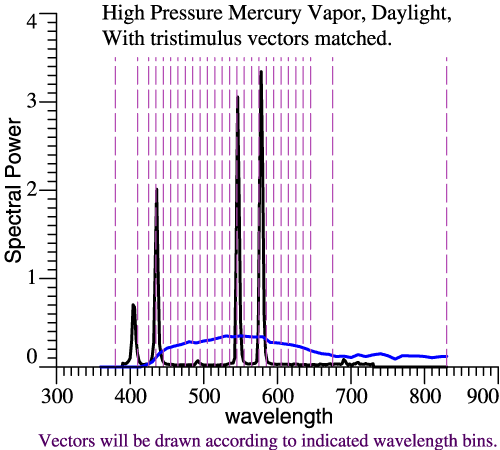 |
| Instead, the color composition of each light will be graphed as a chain of vectors. | |
| Comparing Color
Composition of Lights |
| Now the same two lights are
compared in their vector composition. The smooth chain
of thin arrows shows the composition of daylight.
Slightly thicker arrows show the mercury light. The mercury light radiates most of its power in a few narrow bands, leading to a few long arrows that leap toward the final white point. Compared to “natural daylight,” the mercury light makes a smaller swing towards green, and a smaller swing back towards red. Such a light would leave the red pepper starved for red light with which to express its redness.  |
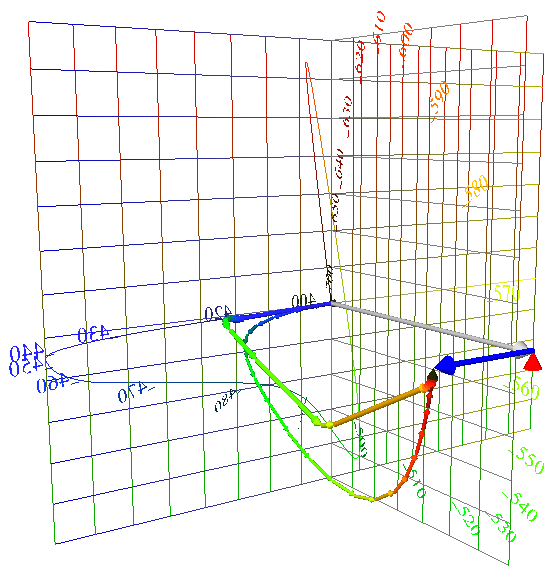 |
| Above two lights are compared by
the narrow-band components of their tristimulus
vectors. At right the same information is shown, but
projected into the v1-v2
plane. The loss of red-green contrast is the main
issue with lights of “poor color rendering,” and that
shows up in this flat graph. If you were really designing lights, you might use the v1-v2 projection as a main tool. You might want to add wavelength labels to the vectors. |
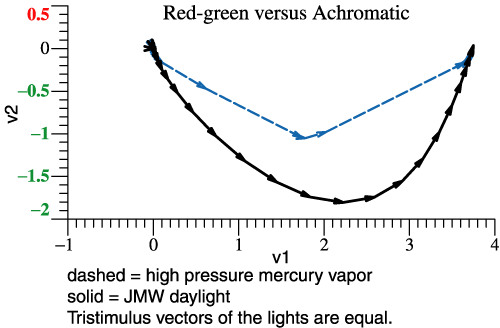 |
| Other interesting data can be
plotted in Cohen’s space. Suppose that the 64 Munsell
chips from Vrhel et al. are illuminated first by
daylight and then by the mercury light. Since the
mercury light lacks red and green, we expect it to
create a general loss of red-green contrast among the
64 chips. The graph at right is a projection into the v2-v3 plane. Each arrow tail is the tristimulus vector of a paint chip under daylight. The arrowhead is the same chip under the mercury light. The lightest neutral paper is N9.5, and is a proxy for the lights. Notice that 3-vectors projected into a plane still have the properties of vectors in the 2D plane. As expected, red and green paint chips suffer a tremendous crash towards neutral. [Michael J Vrhel, Ron Gershon, LS Iwan, "Measurement and analysis of object reflectance spectra.," Color Res. Appl. 1994;19:4–9.] |
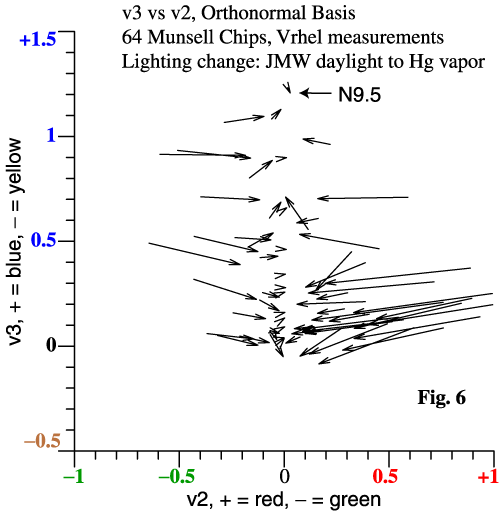 |
| Actual neutral
papers appear as arrows of zero length. For an alternate presentation about comparing lights, please see “How White Light Works,” and the related graphical material. |
|
| Cameras and the
"Maxwell-Ives Criterion" |
| One Stumbling
Block |
| Compare Camera
LUM to that of Human |
| The Fit First
Method |
| Conceptually, the
camera’s LUM (spheres) is more fundamental than the
fit to the human LUM (arrowheads). The trick of the
Fit First Method is to find the best fit first, then
find the LUM from that. Here is the computer code: Rcam = RCohen(rgbSens) # 1
CamTemp = Rcam*OrthoBasis # 2 GramSchmidt(CamTemp, CamOmega) # 3 The camera’s 3 λ sensitivities are stored as the columns of array rgbSens . Because of the invariance of projection matrix R, it doesn’t matter how the functions are normalized, or whether they are actually in sequence r, g, b. Statement 1 finds Rcam, the projection matrix R for the camera. RCohen() is a small function, but conceptually, RCohen(A) =
A*inv(A’*A)*A’ . (7)
In other words, step 1 applies Cohen’s formula for the projection matrix. Then Rcam is the projection matrix for the camera. In step 2, the columns of OrthoBasis are the human orthonormal basis, Ω . The matrix product Rcam*OrthoBasis finds the projection of the human basis into the vector space of the camera. But, the wording about projection is another way of saying that step 2 finds the best fit to each ωi by a linear combination of the camera functions. So, step 2 is the “fit” step. (More programming specifics.) |
|
| Step 2 does 3 fits at
once, but let's look at just one. At right, the dashed
curve is ω1, the human achromatic function.
The camera in question happens to be a Nikon D1. The
solid curve is a linear combination of that camera’s
r, g, and b functions that is the least-squares best
fit to ω1. There would be other ways to
solve the curve-fitting problem, but projection matrix
R is
convenient. A best fit is found for each ωj
separately. The resulting re-mixed camera functions
are not an
orthonormal set. |
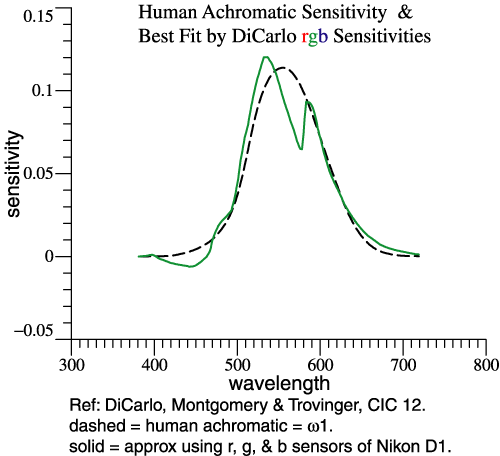 |
| Step 3,
Orthonormalize the Re-mixed Camera Functions |
|
| Since
the
re-mixed camera functions are computed separately,
they are not orthonormal and would not combine to map
out a true Locus of Unit Monochromats. But they mimic
Ω
and are in the right sequence. We need to make them
orthonormal, which is what the Gram-Schmidt method
does, Step 3. |
|
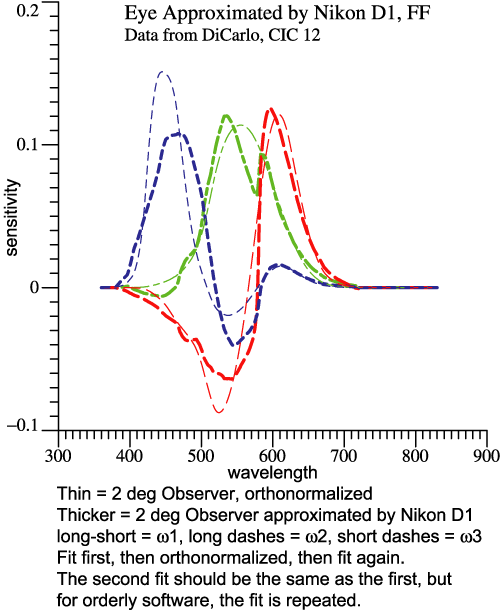
|
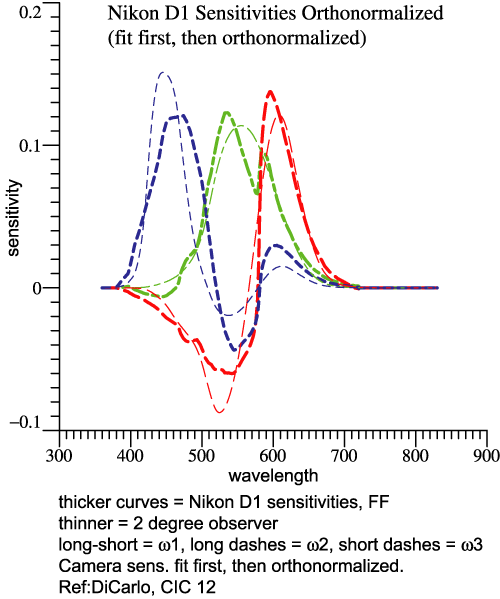 |
|
The two sets of graphs above look similar. But
the one on the left shows the set of “fit” functions.
The one on the right shows the orthonormal basis of
the Nikon D1. The thinner curves pertain to the 2°
observer, the thicker ones to the camera. Why Does
it Matter?
When you have the orthonormal basis, for the
eye or for a camera, you can
do many things with it. Combining the 3
functions generates the Locus of Unit Monochromats.
The orthonormal property leads to some simple
derivations. On the Q&A page, see "Can
we have fun with orthonormal functions?" |
|
| Camera Example,
Nikon D1 |
| The last 4 graphs above
pertained to the Nikon D1, based on data from CIC
12. At right are the camera’s red, green, and blue
sensitivities. The camera’s LUM can be compared to the eye’s. Rather than another perspective picture, we now view the LUMs in orthographic projection (2 graphs below). The dashed curves are the human locus. The solid curves are the camera’s locus, while the tips of the small green arrows are points on the best-fit sensitivity function. |
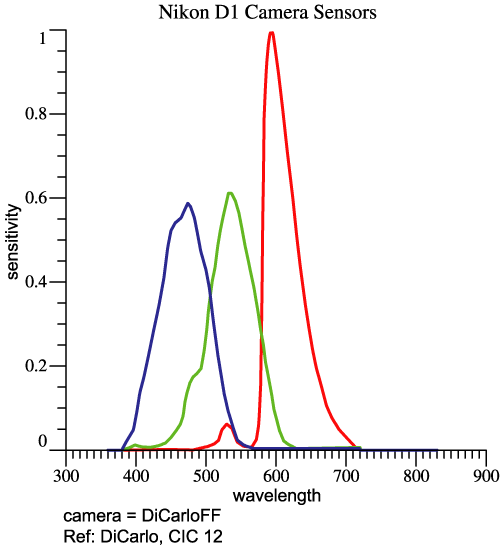 |
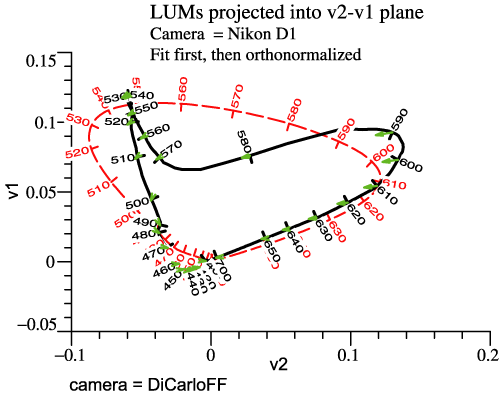 |
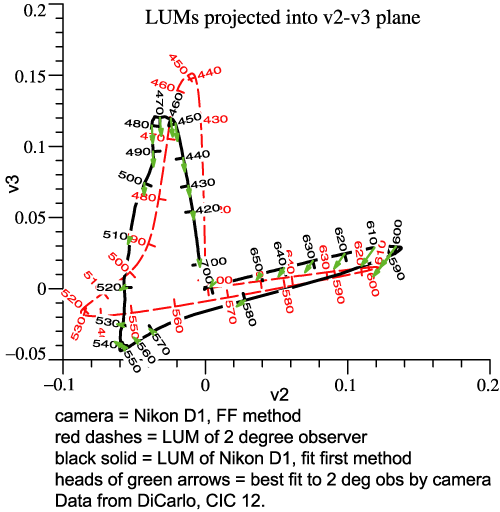 |
| Now you may say “These curves mean
nothing to me!” That may be true at first, but the
graphs contain a complete description of the camera
sensor, with no hidden assumptions, and no
information discarded. Finding Some Meaning
in the Camera's LUM
Consider the left-hand graph, “LUMs projected
into v2-v1 plane.” Only the red and green receptors
contribute to the human LUM in this view, and v1 is
the achromatic dimension for human, based on good
old y-bar. In this plane at least, the particular
camera tends to confuse wavelengths in the interval
510 to 560 nm, which are nicely spread out as
stimuli for human. Yellows, say 560 to 580 nm, have
lower whiteness than they would for human. The
camera has other differences from human that may be
harder to verbalize. To the extent that finished
photos look wrong, one could revisit these graphs
for insight.More Examples
Five detailed examples were prepared in 2006,
and they are linked from the further
examples page. For instance, Quan’s optimal
sensor set indeed looks good in any of the graphical
comparisons to 2°
observer. (See http://www.cis.rit.edu/mcsl/research/PDFs/Quan.pdf
.) |
|
| Something
Completely Different: a 4-band Array Nominal
time: 3:08 pm
|
| Sony publishes a
specification for a 4-band sensor array, the
ICX429AKL. I’m not sure of the intended application,
but it could potentially be applied in a normal
trichromatic camera. The Fit First Method readily
fits the 4 sensors to the 3-function orthonormal
basis. |
|
| The four sensitivities are seen
at right. The key steps look the same: Rcam
= RCohen(rgbSens)
. Recall that
the projection matrix Rcam is a
big square matrix of dimension N×N, where N is the
number of wavelengths, which might be 471. The 4th
sensor adds a column to the array rgbSens, but does
not change the dimensions of the result Rcam. After the key
"fit first" steps, I did have to re-think some
auxiliary calculations because of the 4-column
sensor matrix.CamTemp = Rcam*OrthoBasis GramSchmidt(CamTemp, CamOmega) |
 |
| The camera's
orthonormal basis Rcam comprises 3 vectors that
are linear combinations of the 4 vectors in
rgbSens. I wanted to find the 4x3 transformation
matrix relating the one to the other, in order to
stimulate thinking about noise. The program output
itself explains the method as follows: Similar
to Eqs. 15-18 in CIC 14 paper,
Transform from sensors to CamOmega: We want to solve CamOmega = rgbSens * Y , where Y is coeffs for 3 lin. combs. MPP = inv(rgbSens'*rgbSens) * rgbSens' Y = MPP*CamOmega = 0.24845 0.13737 0.35971 -0.34663 -0.43708 -0.45585 -0.22433 -0.088434 -0.033503 0.26839 0.22522 0.055984 Column amplitudes = vector lgth of each column = 0.55158 0.51812 0.58433 The columns of rgbSens actually contain the 4 sensitivities, cyan, green, yellow, magenta. MPP is the Moore-Penrose Pseudoinverse. (See Wikipedia and pp. 9-10 in "notes.") Keeping in mind that the sensitivities are all >= 0, matrix Y gives some idea how much subtraction is done to produce the sensor chip’s orthonormal basis. That’s a step toward thinking about noise. Below are the 3 orthonormal functions, and also the 3 best-fit functions made from the 4 camera sensitivities. The only source of “noise” is the errors that I introduced while converting graphs to numbers. It becomes more visible here, after subtractions. |
|
 |
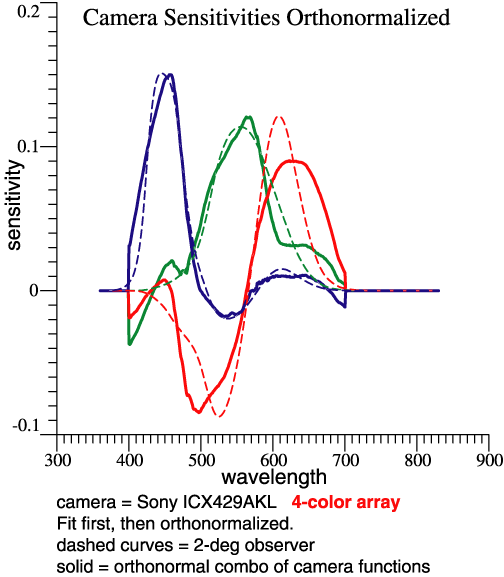 |
|
Some noise also shows up in the projections of the LUM, below. It would appear that color fidelity is not good; reds and oranges may lose some redness. |
|
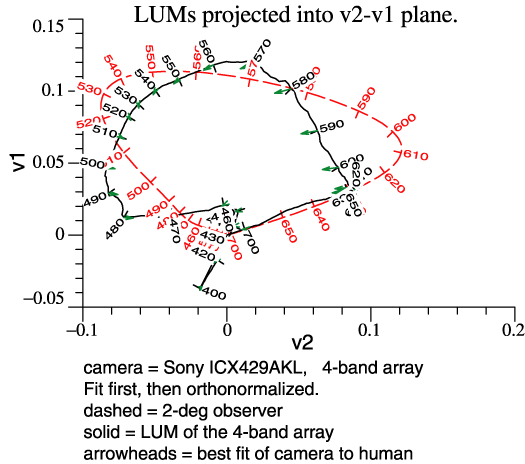 |
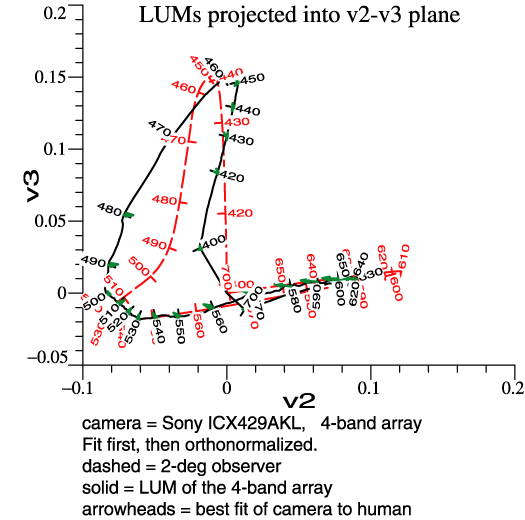 |
| Combining LEDs
to Make a White Light? |
| In
the
1970s, William A. Thornton asked an interesting
question: If you would make a white light from 3
narrow bands, how would the choice of wavelengths
affect vision of object colors under the light? His
research led to the Prime Colors, a set of
wavelengths that reveal colors well. From that
start, he invented 3-band lamps and was named
Inventor of the Year in 1979. He continued his
research and made the definition of prime colors
more precise. Problem Statement: For the 2° Observer, Thornton’s Prime Colors are 603, 538, 446 nm. [See CIC 6, and Michael H. Brill and James A. Worthey, "Color Matching Functions When One Primary Wavelength is Changed," Color Research and Application, 32(1):22-24 (2007). Also see Wavelengths of Strong Action, above.] If you would make a light with 3 narrow bands at those wavelengths, the light would tend to enhance red-green contrasts, making some colors more vivid, though it would do a bad job with saturated red objects. You might think then that a white light could be made from 3 LEDs whose SPDs peak at those wavelengths. This idea falls short because LEDs are not narrow-band lights. Our task then is to see what happens when real LEDs are combined, and design a good combination by speedy trial-and-error. We'll see two graphs per example: the LED spectra and their sum, and then the vectorial composition of the LED light in comparison to 5500 K blackbody. Clicking either image gives more detailed information. Example 1: Let LED Peaks ≈ Prime Colors
The reference white is 5500 Kelvin blackbody.
From 119 types measured by Irena Fryc, 3 LEDs are
chosen by their peak wavelengths, as shown at left.
Then we see at right that the blackbody (blue line)
makes a bigger swing to green and back. This LED
combo will dull most reds and greens. |
|
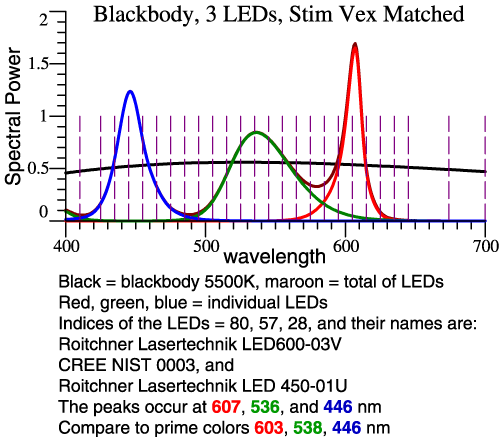 |
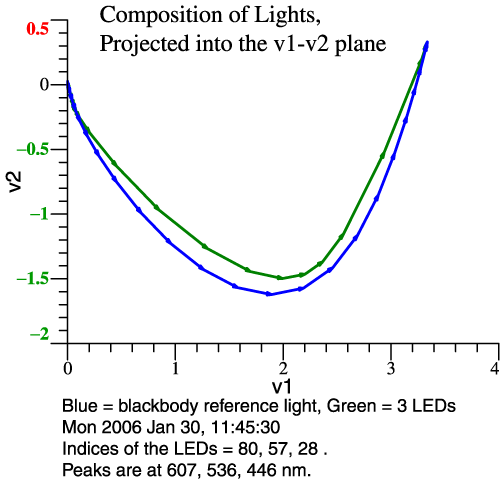 |
|
Example 2: Greener Green and
Redder Red
To increase the swing towards green and back,
we let the green be greener (shorter λ)
and the red be redder (longer λ).
In all cases, the LED amplitudes are adjusted so the
total tristimulus vector matches the blackbody.
|
|
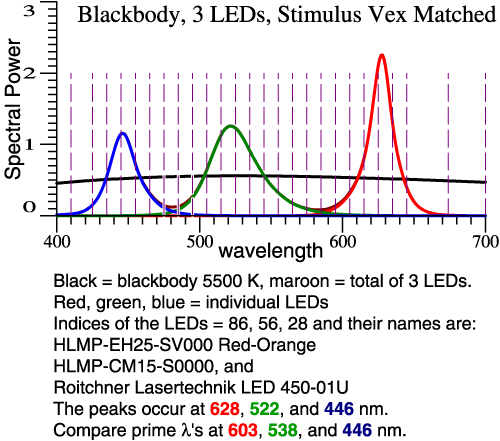 |
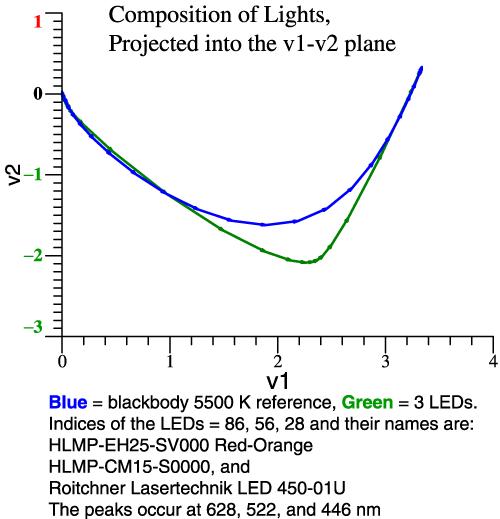 |
| Still
on example 2, we can see from the vector
composition (right-hand graph) that red-green
contrast will be good, but some colors may be
particularly distorted. Clicking the
left-hand graph confirms that idea in the
color shifts of the 64 Munsell papers. Example 3: Broaden the Red Peak
The problem in example 2 is known to some
lighting experts. The light needs to have a broader
range of reds. The remedy is to use 2 red LEDs. For
simplicity, the proportion of the 2 reds is fixed,
not adjustable. |
|
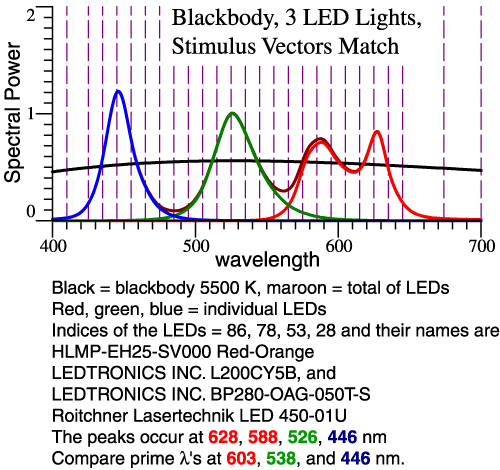 |
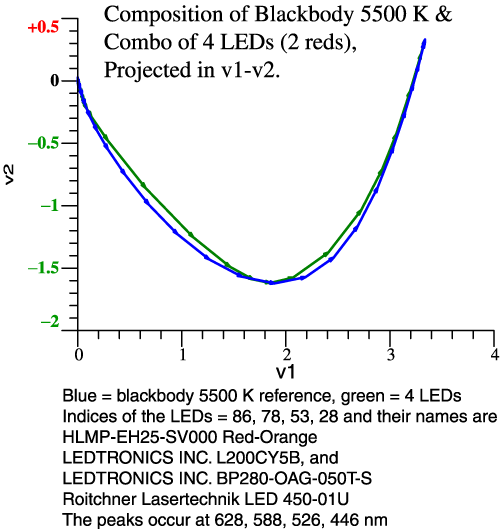 |
| Think of those green and red limit
colors. Some of those colors will still be dulled,
but we are tracking the blackbody pretty close.
Further tweaking is possible. |
|
| Vectorial
Color |
| Invariants |
| Food for Thought ... |
| The End |
|
Please feel free to contact me at any time. I am always eager to discuss lighting, color, cameras etc.
Jim Worthey
|
| Special
Credit |
| Stop |
| Scroll No Farther |
 |
Material Below Addresses Obscure Questions |
|
|
|
|